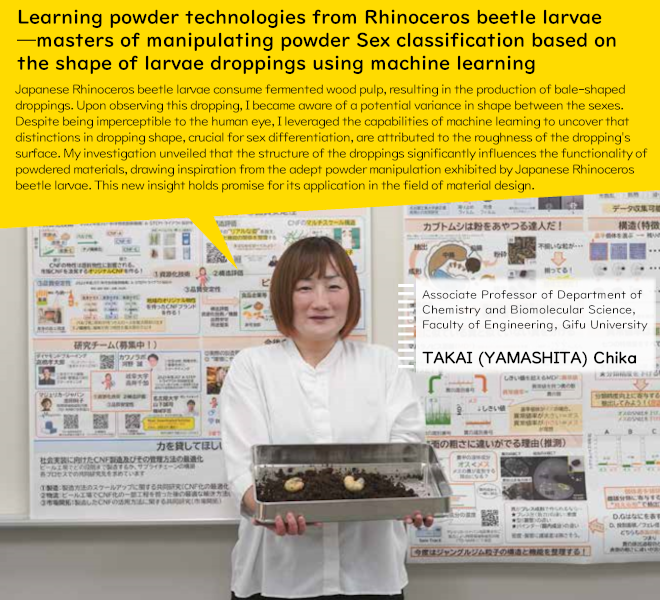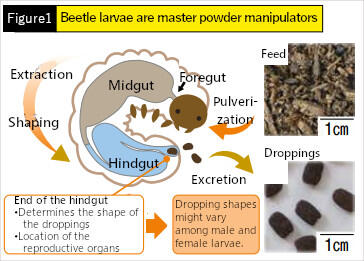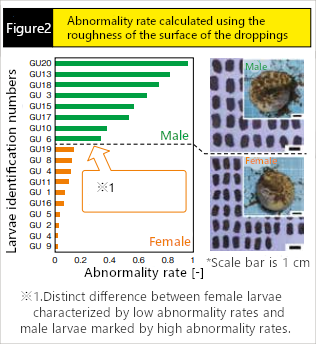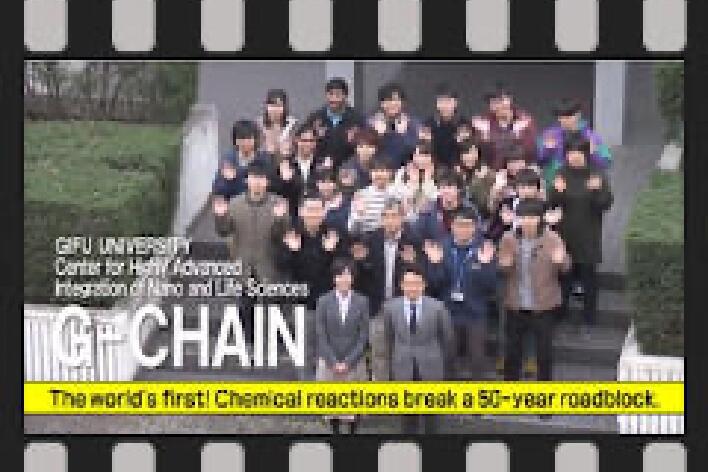Learning powder technologies from Rhinoceros beetle larvae -masters of manipulating powder Sex classification based on the shape of larvae droppings using machine learning
*Information related to faculty members/students and graduate schools at Gifu University here are all that of the time of interviewing.

Nurturing Japanese Rhinoceros beetles alongside my son sparked the inspiration for embarking on this research journey.
My interesting lies in the realm of "powder technology," a scientific domain that encompasses the multifaceted world of "powder." Powder can manifest in various states and forms around us - as finely powdered substances (such as flour), in liquid states (like beverages), and even in bulk forms (think of tableware). Within this field, I am delving into diverse aspects of powder, encompassing technologies for powder creation, methodologies for investigating powder properties, and efficient means of powder utilization.
Amidst the backdrop of the COVID-19 pandemic, when both my workplace and my son's nursery were shuttered, I found myself grappling with a sense of despondency. As a researcher in the engineering field, I pondered whether I had contributions to offer the world. Yet, in that moment, I had an epiphany - "I should seize this opportunity to embrace my time at home." Consequently, I commenced my observations of the beetle larvae my son was nurturing.
 In the past, I harbored a strong aversion to insects, so much so that encountering a lifelike insect toy could elicit a scream from me. However, my feelings evolved as I immersed myself in the world of insect-raising, a pursuit I undertook alongside my son through shared exploration of picture books. The Japanese Rhinoceros beetle larvae utilized their robust mandibles to chew and consume the breeding mat composed of fermented wood chips, eventually excreting distinctive bale-shaped droppings. Once these droppings became noticeable, it necessitated a mat replacement. Finding it wasteful to discard still serviceable mats, I embarked on the task of sifting the droppings from the mat. As the varied shapes and sizes of the mat fragments passed through the sieve, uniform-shaped and sized droppings began to emerge. Remarkably, even when subjected to vigorous shaking, the droppings retained their shape. The finely pulverized particles of the mat, resulting from the mandibles of the larvae, served as the foundational material shaped within the larvae's guts. It dawned on me that the larvae capable of excreting these bale-shaped droppings were indeed "masters of powder manipulation," employing powder technology to craft their droppings. While no discernible disparity in dropping shape was apparent between male and female larvae, I discovered that the proximity of the larvae's reproductive organs to their hindgut played a pivotal role in determining droppings shape. This revelation led me to contemplate whether there might exist differences in droppings shape between male and female larvae.[Figure.1]
In the past, I harbored a strong aversion to insects, so much so that encountering a lifelike insect toy could elicit a scream from me. However, my feelings evolved as I immersed myself in the world of insect-raising, a pursuit I undertook alongside my son through shared exploration of picture books. The Japanese Rhinoceros beetle larvae utilized their robust mandibles to chew and consume the breeding mat composed of fermented wood chips, eventually excreting distinctive bale-shaped droppings. Once these droppings became noticeable, it necessitated a mat replacement. Finding it wasteful to discard still serviceable mats, I embarked on the task of sifting the droppings from the mat. As the varied shapes and sizes of the mat fragments passed through the sieve, uniform-shaped and sized droppings began to emerge. Remarkably, even when subjected to vigorous shaking, the droppings retained their shape. The finely pulverized particles of the mat, resulting from the mandibles of the larvae, served as the foundational material shaped within the larvae's guts. It dawned on me that the larvae capable of excreting these bale-shaped droppings were indeed "masters of powder manipulation," employing powder technology to craft their droppings. While no discernible disparity in dropping shape was apparent between male and female larvae, I discovered that the proximity of the larvae's reproductive organs to their hindgut played a pivotal role in determining droppings shape. This revelation led me to contemplate whether there might exist differences in droppings shape between male and female larvae.[Figure.1]
Coincidentally, my husband, who is also a researcher (Assistant Professor YAMASHITA Seiji at Nagoya University), had just started research on machine learning, and he told me about the Maharanobis Taguchi (MT) method, which is often used in quality engineering. This is a skilled way of detecting minute differences that are not visible to the naked human eye. Therefore, we decided to tackle this question together, as it may be possible to detect whether there were differences in the size of the droppings between male and female larvae. The MT method helps recognize and classify differences in patterns based on the correlation between multiple sets of variable data. It is a means of classification in which any group is selected as the reference from the sample you want to classify, and the items are evaluated and classified based on whether the abnormality rate is small or large depending on whether the evaluated data and the pattern are similar or dissimilar. Specifically, droppings excreted by 20 larvae were lined up and photographed, and the feature data showing the shape of the droppings, including the size of the droppings, projected area ratio, and circumference, were collected using an image analyzing software. One of the larvae was selected as the reference, and the abnormality rate of the remaining larvae was calculated. The droppings were classified as follows: if a female was selected as the reference, and the abnormality rate was small, then the data pattern was similar and the droppings were from a female larva; however, if the abnormality rate was large the droppings were from a male larva.
 Not all features can be used for classification. There are also features that do not contribute to the classification of male and female larvae. Only features that contribute to the classification are extracted, using a method called cause analysis, to improve the classification accuracy. This time, I realized that the roughness of the surface of the droppings corresponded to this type of feature. Furthermore, using this feature enabled 100% of the droppings to be classified as male or female based on the shape alone. Neither my husband nor I thought that we would be able to classify the droppings as male or female based on shape alone; therefore, when we successfully achieved this classification, we danced around the house with joy, much to the disdain of our son. There is no substitute for the excitement you experience when you prove your theory with research, and that feeling truly highlighted how interesting research is. Currently, I currently aim to learn from the techniques used by Japanese Rhinoceros beetle larvae, who are master manipulators of powder, and apply my findings to classify structures that can maximize the appeal of powder materials. The results of my research have been published and are available for open access in the Advanced Powder Technology Journal. Kindly read the article if you would like to obtain further information *1.
Not all features can be used for classification. There are also features that do not contribute to the classification of male and female larvae. Only features that contribute to the classification are extracted, using a method called cause analysis, to improve the classification accuracy. This time, I realized that the roughness of the surface of the droppings corresponded to this type of feature. Furthermore, using this feature enabled 100% of the droppings to be classified as male or female based on the shape alone. Neither my husband nor I thought that we would be able to classify the droppings as male or female based on shape alone; therefore, when we successfully achieved this classification, we danced around the house with joy, much to the disdain of our son. There is no substitute for the excitement you experience when you prove your theory with research, and that feeling truly highlighted how interesting research is. Currently, I currently aim to learn from the techniques used by Japanese Rhinoceros beetle larvae, who are master manipulators of powder, and apply my findings to classify structures that can maximize the appeal of powder materials. The results of my research have been published and are available for open access in the Advanced Powder Technology Journal. Kindly read the article if you would like to obtain further information *1.
Related videos are also available on the Gifu University official website, Glocal Lesson
※:C. Takai-Yamashita, S. Yamashita et al., Adv. Powder Technol., 2022. https://doi.org/10.1016/j.apt.2022.103552
I want to convey how interesting research is to young students.

After obtaining my doctorate (Engineering) in 2007, I worked in the private sector. I completed a post-doctorate program before ultimately deciding to take a break from work to have a baby and raise my son. I also went to Switzerland to further my studies. The researchers at the institution where I conducted my research enjoyed activities and interests other than research. My mentor, Dr. Sébastien Vaucher, was very familiar with Japanese tea and had several interests, including karate, yoga, and music. I was initially hesitant about going alone to study in Switzerland and leaving my 3-year-old son in Japan; however, my fellow researchers in Switzerland opened my eyes to a new world and emphasized that I could do what I want to do, regardless of being a mother, and I should aim to be the researcher I aspire to be. Had I not gone to Switzerland to study, I may not have conducted research on the beetle larvae.

Research is an accumulation of resolving familiar questions. The clues to resolving these questions may sometimes be found in unexpected places. I feel that there are still new discoveries to be made in materials that everyone is familiar with. I aim to share the excitement and joy of research with young students, inspiring them to consider the path to becoming a researcher as a viable option for the future. While achieving this, I also want to fully enjoy research.





